Medical Disclaimer: The information in this blog is for enlightening and educational purposes only and is not intended as medical advice. The content in this post is not meant to substitute for a professional medical diagnosis, advice, or treatment. Always ask advice from your physician or other qualified health providers with any questions you may have regarding a medical condition.
Squats are considered a fundamental exercise [1] in many strength and conditioning routines, primarily targeting lower-body strength.
Elbow pain during squats is more common than you think, and it can leave you frustrated and unsure of what’s going wrong. Whether you’re new to squatting or lifting heavy, pain in your elbows can pop up unexpectedly.
But why does it happen?
And more importantly, how can you fix it? In this post, we’ll uncover the surprising reasons behind elbow pain during squats and share simple solutions to help you squat without the pain. Keep reading to find out what’s going on!
The elbow is a hinge joint [2] with complex movement patterns, but overuse or improper technique can lead to pain and discomfort. Elbow pain can be in different parts: the front (anterior), inside (medial), outside (lateral), or back (posterior).
Understanding Elbow Pain During Squats
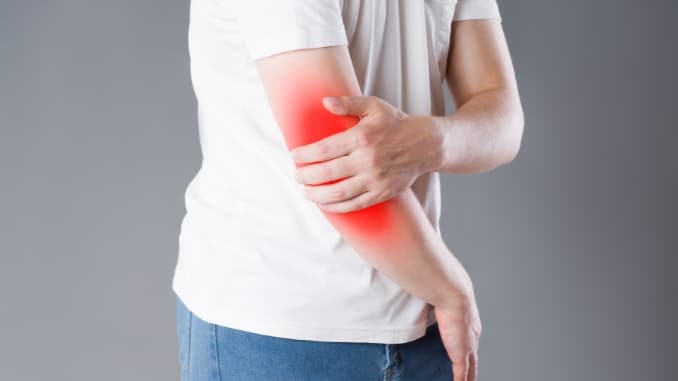
Elbow pain during squats often happens because of the way your arms and elbows are used to hold the barbell. While squats mainly work your legs, your upper body still plays a key role in stabilizing the weight.
In back squats, when the barbell rests on your upper back, your arms and elbows are responsible for gripping and supporting it. If your grip or elbow position isn’t quite right, it can put unnecessary strain on the elbows, leading to pain or discomfort.
Some common causes of elbow pain during squats include:
- Improper Grip: Holding the bar too tightly or too loosely can cause strain on your elbows. A firm, balanced grip is key.
- Wrong Elbow Positioning: If your elbows are pointed too high or low, it can create tension in the elbow joint.
- Wrist Flexibility: Limited wrist mobility can affect how you position your arms and elbows, leading to pain.
- Uneven Bar Placement: If the bar isn’t positioned evenly across your back, it can shift during the squat, causing compensatory adjustments in your arms and elbows that lead to strain.
How Squatting Can Affect the Elbows (Simplified)
1. Squat Mechanics and Elbow Strain
The way you grip the bar during a barbell squat can influence the amount of stress placed on your elbows. In a back squat, your hands grip the bar behind your neck, which might stretch your elbows and wrists, causing discomfort. In a front squat, you need to keep your elbows up to hold the bar, which can put pressure on your elbows.
2. Barbell Squats vs. Bodyweight Squats
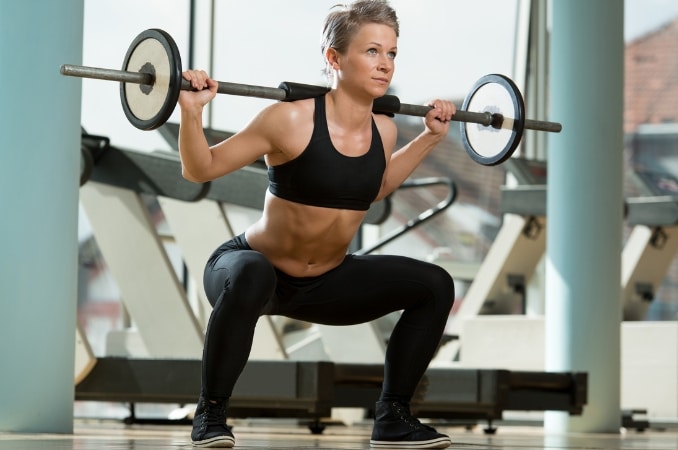
- Barbell Squats: The extra weight from the barbell can put more stress on your elbows, especially if you grip the bar too tightly or use poor form.
- Bodyweight Squats: These are usually easier on the elbows since there’s no extra weight. But bad form or awkward hand positions can still cause some discomfort.
3. Elbow Pain in Different Squat Types
- Front Squats: The elbows are forced to stay high to hold the bar, which can be tough on them, especially if you don’t have enough wrist or shoulder flexibility.
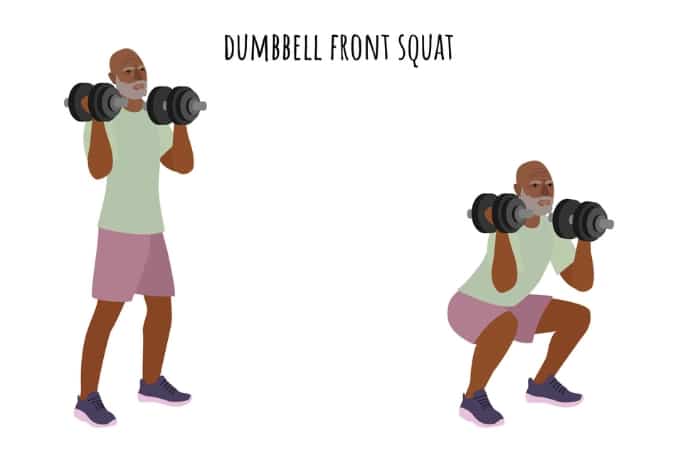
- Back Squats: While the back squat isn’t as hard on the elbows, a bad grip or bar position can still lead to pain.
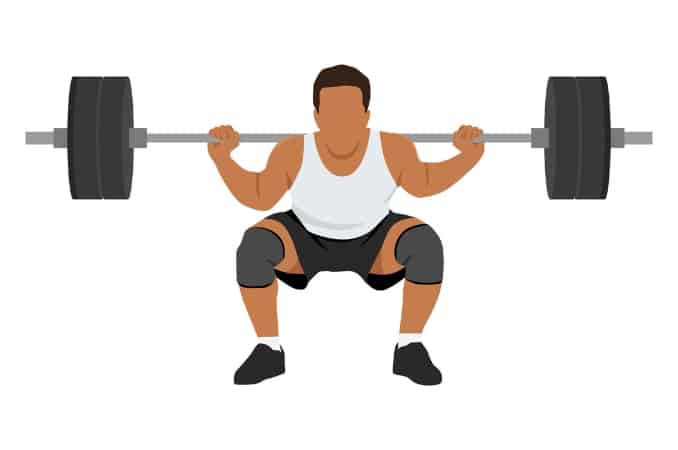
- Overhead Squats: Holding the bar overhead puts a lot of pressure on your elbows, especially if your arms aren’t locked out fully or if you have shoulder or wrist weakness.
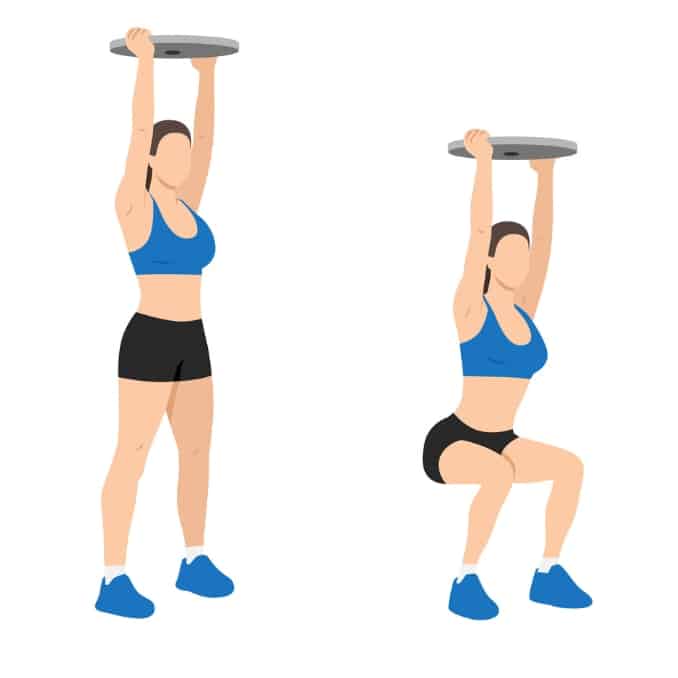
Proper Squat with Barbell Technique and Form
- Begin standing with your feet shoulder-width apart and the barbell resting on your upper back. Keep your chest tall and engage your core.
- Slowly bend at the hips and knees to lower your body, pushing your hips back as you squat down.
- Keep your knees aligned with your toes, ensuring they don’t cave inward.
- Lower your body until your thighs are parallel to the ground, or deeper if your flexibility allows.
- Maintain a neutral spine throughout the movement.
Once you reach the bottom of the squat, push through your heels and extend your legs to return to the standing position. Keep your chest lifted and your core engaged to protect your lower back. Repeat the movement for the desired number of reps.
Key Tips: [3]
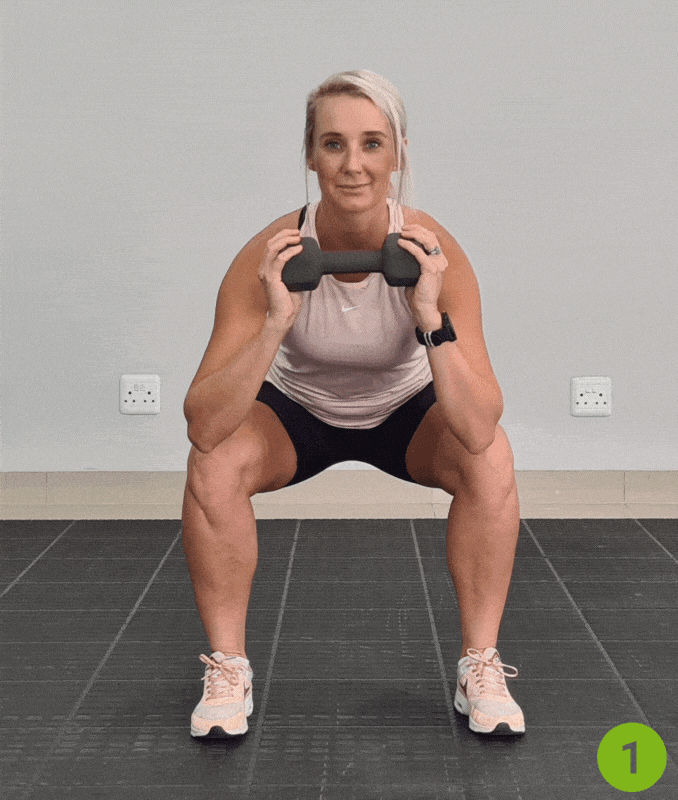
- Feet should be shoulder-width apart, with a natural foot position.
- Knees should move freely forward without restriction, staying aligned with the toes.
- Keep the trunk upright and gaze forward or slightly upward.
- Keep the barbell centered over your mid-foot, not letting it drift forward or backward.
- Keep your gaze straight ahead or slightly upward to help maintain spinal alignment.
Dr. Aaron Horschig suggests avoiding pulling your elbows too far forward when holding the bar. Instead, keep your elbows slightly back and engage your shoulder blades by squeezing them together.
Grip Width and Wrist Alignment Considerations
- The width of your grip can influence the stress on the elbow joint, with a wider grip often reducing stress, but potentially compromising overall form.
- A wider grip can reduce stress on the elbow, but may compromise form.
- Wrist position is critical, as hyperextension can lead to abnormal stress on the elbow joint.
- Keeping the wrists in a neutral position can help reduce stress on the elbow.
- Adjusting grip width and wrist position can help alleviate elbow pain.
Managing Elbow Pain During Training
- Reducing training volume and intensity, especially exercises that exacerbate elbow pain, can help alleviate discomfort.
- Modifying exercises, such as using a thumbs-around grip, can help reduce stress on the elbow.
- Incorporating exercises that strengthen both the forearm flexors and extensors can help alleviate elbow pain when squatting by promoting balanced muscle development.
- Taking regular breaks and stretching can help reduce muscle tension.
Prevention and Maintenance
- Maintaining proper squat technique and form can help prevent elbow pain.
- Incorporating exercises that strengthen the upper back and shoulder external rotation can help prevent elbow pain when squatting.
- Regularly stretching and foam rolling can help maintain flexibility and reduce muscle tension.
- Monitoring and adjusting training volume and intensity can help prevent elbow pain.
Conclusion

Elbow pain when squatting is a common issue, but it can be effectively managed with the right techniques. Ensuring a proper grip, correct elbow positioning, and good wrist mobility are essential to prevent strain on your elbows.
By maintaining proper squat form, adjusting your grip width, and incorporating strengthening exercises, you can reduce pain and improve your performance. Regular stretching and monitoring training intensity also play a key role in preventing future discomfort.
Tennis elbow can have a devastating effect on your quality of life, making everyday tasks a challenge. Even something as simple as lifting a cup of coffee or playing with your kids can become impossible. So fix it—fast—with the Tennis Elbow Pain Solution. Check out now!
Frequently Asked Questions
How do I fix my elbow pain from the gym?
Start by identifying what’s causing the pain—overuse, poor form, or muscle imbalances. Rest the area, reduce any exercises that aggravate it (like bench press or low bar squats), and use ice if it’s inflamed. Focus on proper technique, and consider stretching and strengthening the forearms, upper traps, and shoulders. If pain doesn’t improve, it’s best to consult a healthcare or rehab professional.
How to fix elbow pain with squatting?
Check your squat form—especially how you hold the bar. Adjust your squat grip and elbow position to reduce strain. Improving shoulder and wrist mobility is key, as stiffness there can force your elbows into uncomfortable positions during movements like low bar squats. Lighten the load temporarily, and give your elbows time to recover. If pain continues, pause barbell squats and seek guidance from a coach or physical therapist.
What is Squatter’s elbow?
“Squatter’s elbow” isn’t a formal diagnosis, but some lifters use it to describe elbow pain caused by barbell squatting—usually from poor squat grip, tight shoulders, or bar placement (such as in the low bar squat) that puts stress on the elbows. It’s more about strain than injury and often improves with mobility work and a better squat setup.
How to stop arm pain when squatting?
Try widening your grip or adjusting your hand position on the bar. Make sure the bar is evenly placed and your wrists aren’t overly bent. Strengthening your upper traps and improving flexibility in your shoulders and wrists can also help. If the pain sticks around, switch to squat variations that don’t stress your arms, like safety bar or goblet squats.


